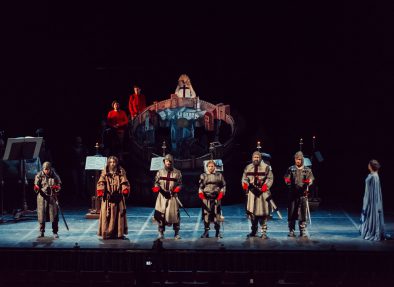La Conquista de Jerusalén

La Conquista de Jerusalén por Godofre de Bullón is one of the plays contained in the manuscript which the Italian Hispanist Stefano Arata discovered in the library of the Royal Palace in Madrid and publicly presented in 1991, thereby identifying the Jerusalén Cervantes mentions in his Adjunta al Parnaso (1614) among the works he wrote after his period of captivity. Indeed, this newly discovered play bears several metrical and dramatic similarities to El trato de Argel and La Numancia and, like them, can be dated to around 1585.
Cervantes adapts for the stage Torquato Tasso’s epic poem La Gerusalemme liberata (1581) with his own mixture of history and fiction featuring many characteristic ingredients of Spanish Golden Age comedy – false identities, disguises, final recognitions – and dialogues between contrasting characters like those maintained subsequently by Don Quixote and Sancho in his universally famous novel. The play, which combines allegorical and real characters, episodes of war and love tangles, begins with the arrival of the crusade army at the gates of Jerusalem to lay siege to the city, which is under Muslim control. The scenes, which take place on both sides of the wall, with the crusaders camped outside in preparation for the siege and the Muslims barricaded inside, are interspersed with Tancredo’s undeclared love for the Moor Clorinda and that of the young princess Herminia for Tancredo, her former captor.
Directed by Juan Sanz, the company Antiqua Escena, the instrumental group La Danserye and the choir Capella Prolationum alternate the text of the play with music from the period – pieces by Juan del Enzina, Mateo Flecha and Francisco Guerrero – to give an idea of the original production based on the stage directions in the manuscript. An abbreviated version of the text has been used here, and Emilio Gutiérrez Caba and Ana Martín Puigpelat provided advice on the diction. Eight actors, five musicians and an eight-voice choir take part in the performance, with costumes designed by Pepe Corzo and sets by Miguel Ángel Coso. As in Golden Age open-air theatres, the actors play several roles in order to bring to life the siege of Jerusalem in 1099 during the First Crusade. The end of the production reminds us that today, as then, those lands continue to be the object of bloody fighting between people of different creeds.
Director
Juan Sanz
In association with
Semana de Música Religiosa de Cuenca, Fundación Unir, CEEH
Production
Lyricist
Emilio Gutiérrez Caba and Ana Martín Puigpelat
Set designer
Miguel Ángel Coso
Costume design
Pepe Corzo
Lightning designer
Mikel Corral
Version of the text
Ana Martín Puigpelat, Dolores Noguera and Juan Sanz
Cast
Kiti Mánver, Juan Díaz, Marta Megías, Badia Albayati, Javier Laorden, Juan Viadas, Jacobo Muñoz, Alejandro Valenciano, Consuelo Trujillo and Antonio Luque
Music
Instrumental group La Danserye and the choir Capella Prolationum
Buy on our site and save 5% until January 5 (Coupon code: NAVIDAD 2025)
